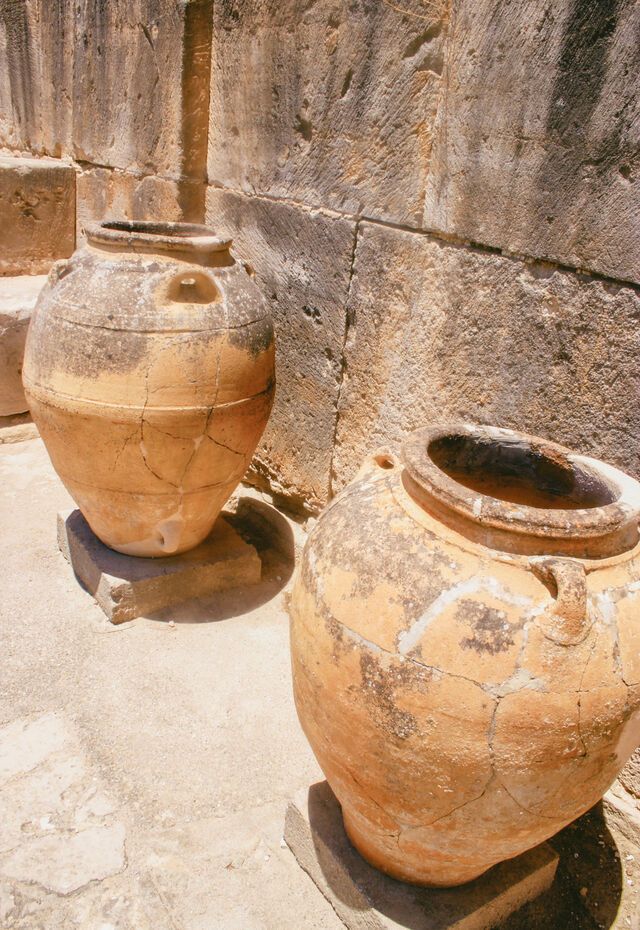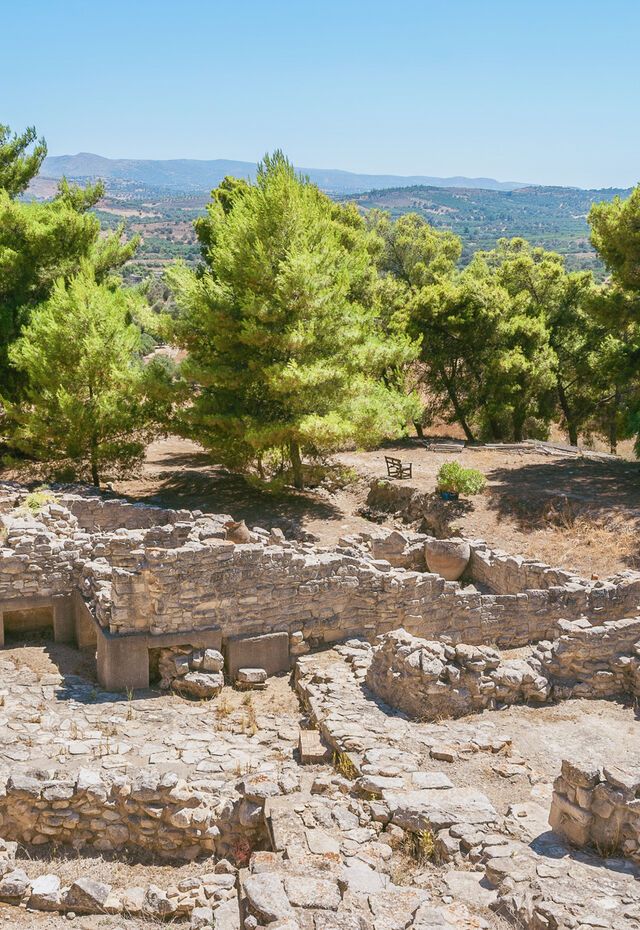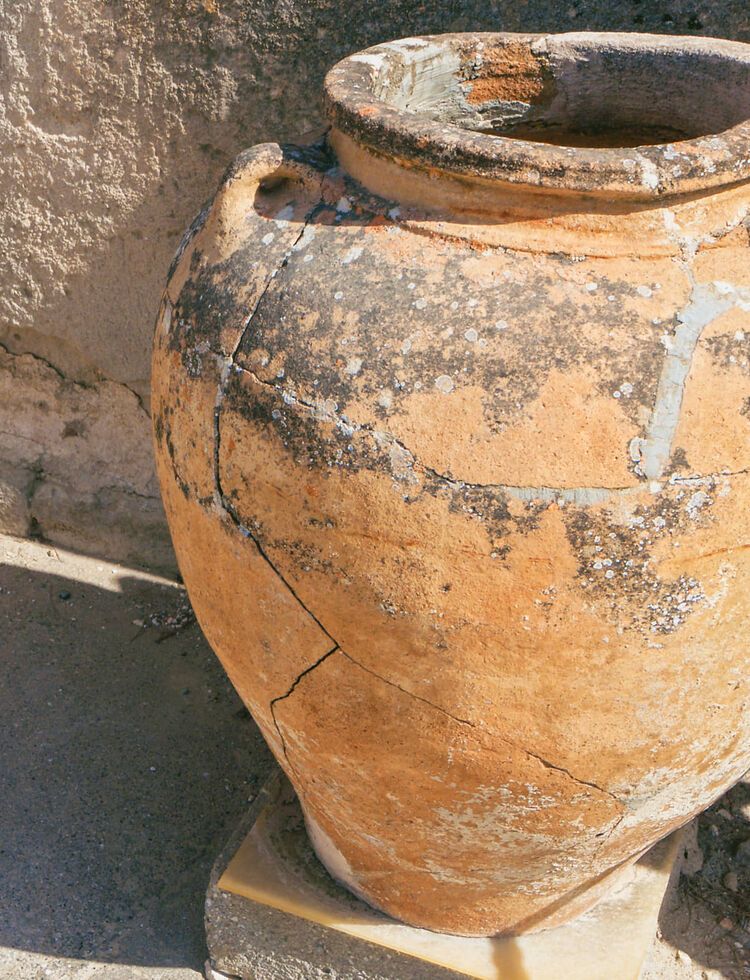

OVERVIEW
Around 60km south of the city of Heraklion, close to Matala and other seaside resorts in southern Crete, the Palace of Phaistos is one of the most important remains of Europe’s oldest civilisation, the Minoans. But before you get complacent about taking a tour around yet another Greek ruin, just consider how old that makes it.
The first palace erected here was in around 2000 BC. Destroyed in an earthquake, it was replaced by a second palace in around 1700 BC which, despite also being destroyed in an earthquake shortly after, established Phaistos as the most powerful city in southern Crete, rivalling the Palace of Knossos in Heraklion for power.
It was mentioned by the historian Pausanias, immortalised as part of the tales of the Trojan War by Homer and, in mythology, was the seat of King Rhadamanthus, the son of Zeus and brother of Minos. It also gave us the Phaistos Disc, one of the earliest and most fascinating examples of writing, on display at the Archaeological Museum of Heraklion.
Built on a hill overlooking the fertile plain of Massara and with views of Mt Psiloritis (Crete’s tallest mountain) as well as Mt Asterousia and the Lasithiotika mountains, the palace offers the perfect excuse to explore the wider region of Heraklion. Best of all, as soon as you’re done, the beaches and tavernas on Crete’s south coast beckon for the rest of the day. The Minoans clearly had a great eye for a location.
DON'T MISS
Highlights of the Minoan Palace of Phaistos in Crete
Northwest (Upper) Court
Your tour starts at what is believed to be the main entrance of both the Old and New Palace. Looking over the remains, you can appreciate how the palace was built over three terraces, with a Processional Causeway running from north to south, and a Central Court dominating the layout. This is perhaps the best angle to observe what little is left of the many rooms and warehouses serving a community of 18,000 during the time of the First Palace Period and reaching an estimated 100,000 in the wider city by 1700 BC.
West (Theatral) Court
Just below the Upper Terrace, the West Court is notable for the 8 rows of stone seating, each more than 20m wide and capable of gathering an audience of more than 400 people in total. From what we know of Minoan civilisation, the events staged here would have been religious ceremonies and political or community gatherings rather than theatrical productions.
The Propylon (or Propylaion)
Even though the palace buildings are largely destroyed, the layout will naturally take you from the West Court towards the 14m wide monumental staircase next. Note how the steps slope downwards (presumably for rainwater to wash away) and look out for the remains of the columns of the once-covered Propylon or portico at the top, serving as a corridor to the Central Court.
Central Court
At 55m long and 25m wide, the Central Court was the hub of social and political activity at the palace. Though you will have stepped into the stone-paved courtyard through what was once its main entrance, you will be able to make out the remains of other corridors and entrances, helping you understand its architectural importance in communicating with other rooms and spaces of the palace. On either side would have stood porticos with alternating pillars and columns.
East Court
Northeast of the Central Court are the remains of a section of the palace with a kiln in the centre for smelting metals and no other remarkable feature – until you learn that this is where the legendary Phaistos Disc was discovered in 1908. The 15cm in diameter disk is believed to date from the middle of the Minoan Bronze Age, with concentric stamped symbols (241 ideograms, 45 of them distinct) whose meaning still escapes us. Visit the Archaeological Museum of Heraklion, where the disk is one of the prized artefacts, and see if you can crack the code.
Queen’s Apartments
The last part of your tour brings you to the royal residence at the palace’s North Wing. The smaller Queen’s Apartment comes first, featuring a lightwell (typical of Minoan palatial architecture) as well as sections of flooring and walling with original alabaster (gypsum) slabs and frescoes.
The King’s Megaron
Finally, just to the north, the King’s room also features a lightwell, slabs of alabaster flooring and fresco-decorated walls. The key feature, however, is a lustral basin in a small chamber at the bottom of a short staircase in which cleansing (a religious ritual) would have taken place. There are remains of lustral basins elsewhere in the palace but none as complete as this.
GET PLANNING
How do you get to the Minoan Palace of Phaistos in Crete?
- The Minoan Palace of Phaistos is 55km (around 1hr by car) from Heraklion Airport and 132km (around 2hr 15min) from Chania Airport.
- It is 60km from the centre of Heraklion.
- You can also reach the palace by bus from Heraklion.
How do you get to Heraklion?
- Heraklion Airport is the largest airport in Crete and receives direct international flights during the summer and domestic flights from Athens and Thessaloniki throughout the year.
- If you are travelling from Chania (142km), take the bus (KTEL) or go by car. Likewise, if you are staying in Rethymno (82km) you can reach Heraklion by KTEL bus or car.
When is the best time to visit the Minoan Palace of Phaistos in Crete?
- The Palace of Phaistos is open all year round, so the best experience will be to visit in May-June or September-October when the weather is still hot enough to swim but there are fewer visitors.
- If you visit Crete in the summer months, it is best to experience Phaistos in the morning or late afternoon when it is cooler and not as busy.
More info for opening hours & tickets
- Autumn
- Spring
- Summer
- Winter
How long do you need to visit the Minoan Palace of Phaistos in Crete?
- Around 1-2hrs at the Palace of Phaistos will give you an insight into Minoan civilisation in Crete, but you could always add other cultural landmarks of Heraklion to your itinerary by including neighbouring Agia Triada and Gortyna to your day.
- Most guided tours last 1-3 hours and some include other nearby archaeological sites.
- Around 15km from the Palace of Phaistos is the archaeological site of Gortyna (famous for the 5th-century BC Gortyn Code, the oldest and most complete example of ancient Greek law, inscribed in stone) and even closer (3km) is the archaeological site of Agia Triada.
- Visiting Phaistos can easily be combined with a swim, with some of the best beaches in Heraklion found nearby. You can choose between Matala, Kokkini Ammos, Komos and Agiofarago (for the more adventurous).
- There’s little shade and the Palace of Phaistos is expansive so don’t forget your hat, sunglasses and sunscreen and bring a water bottle.
- There is a canteen for water and snacks near the site.
- Wear comfortable footwear.
- You can book an organised tour with Cretan Guides.


